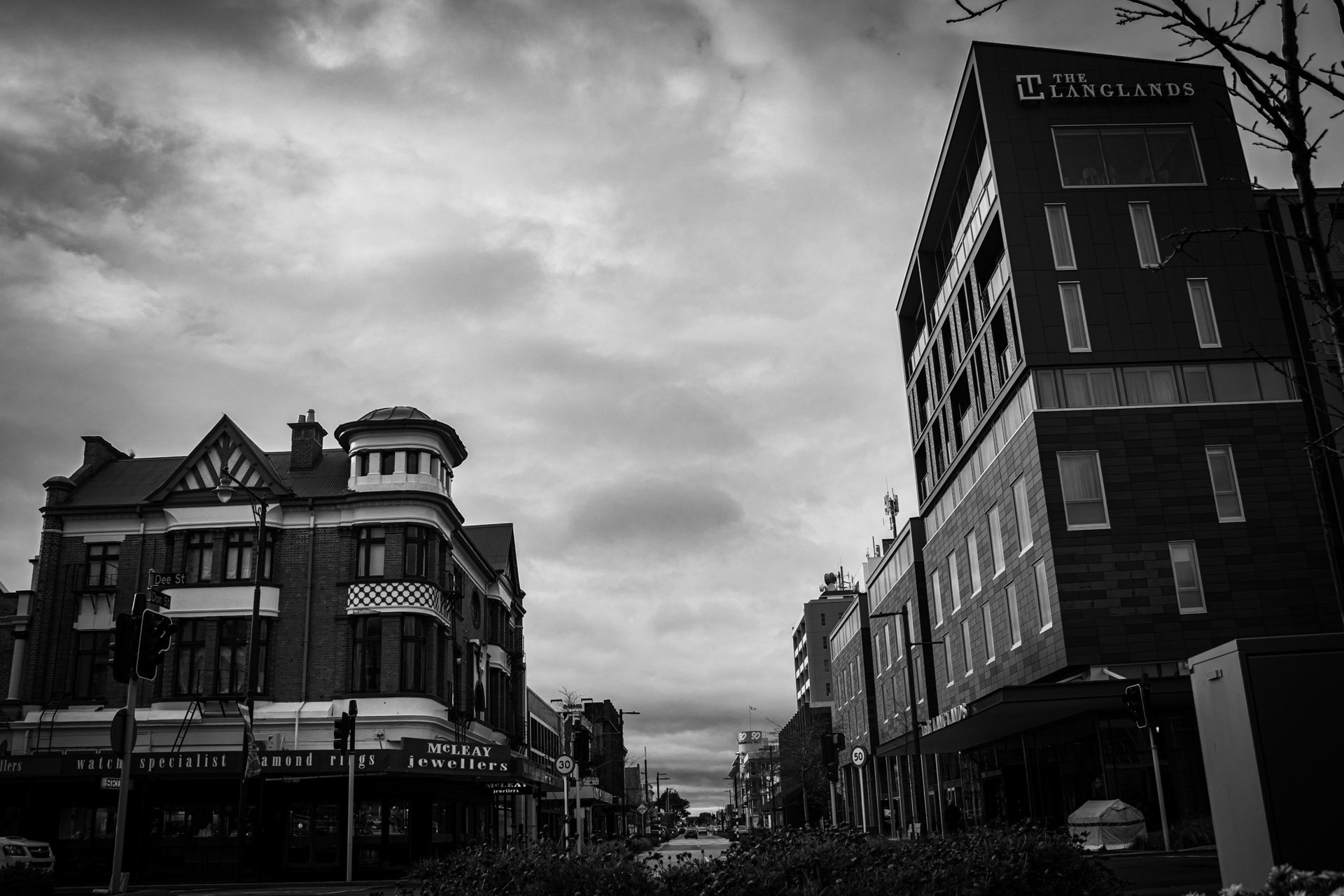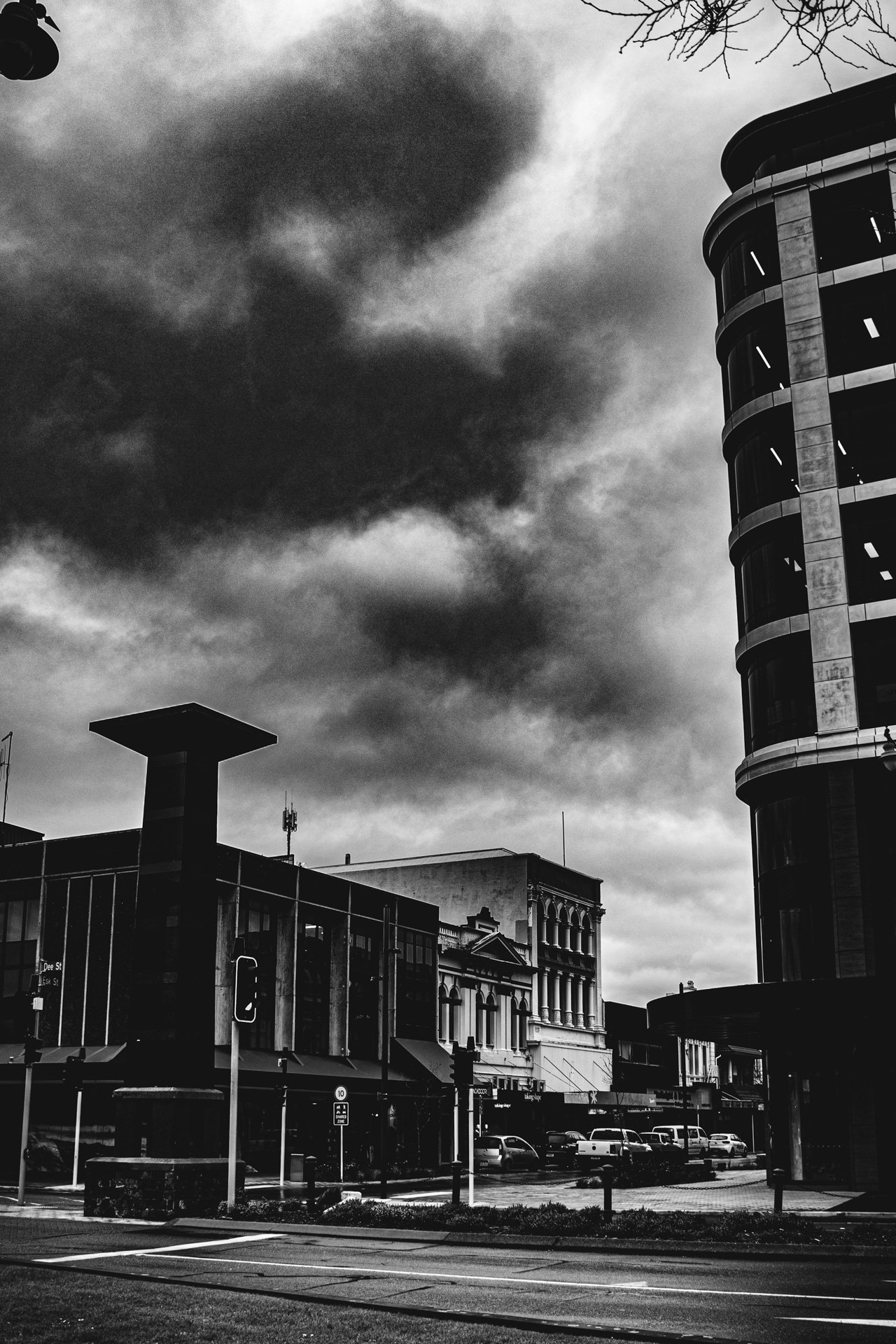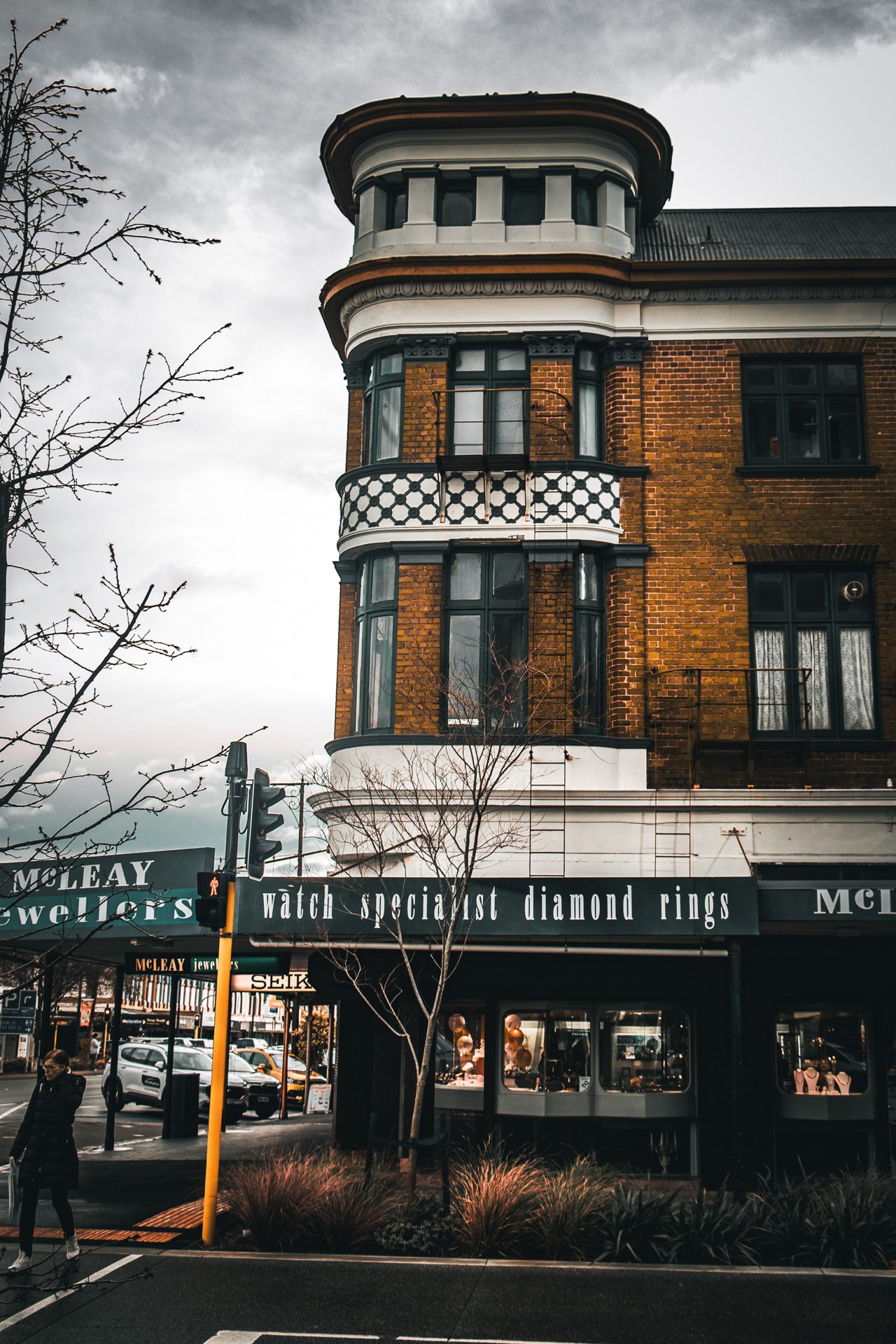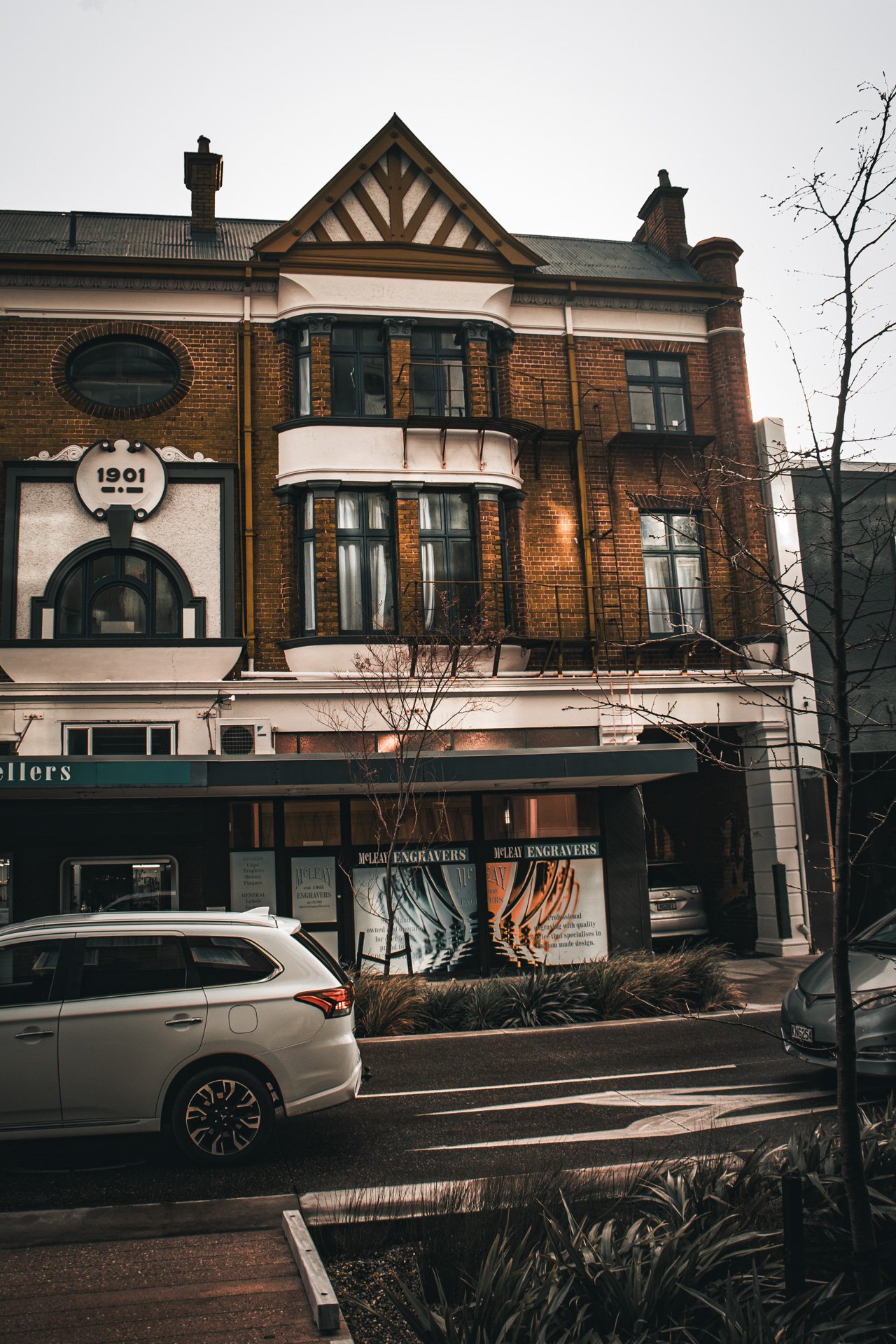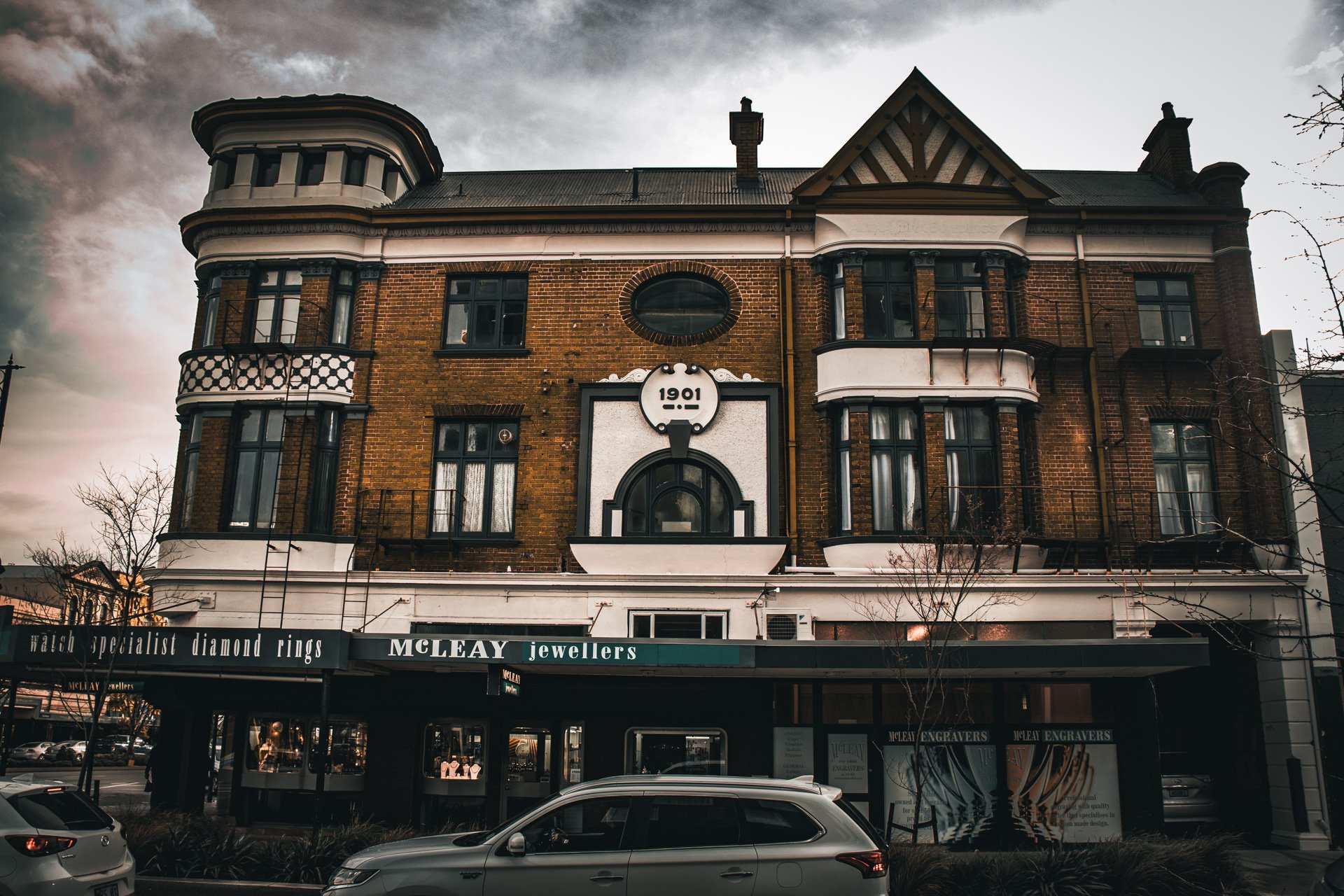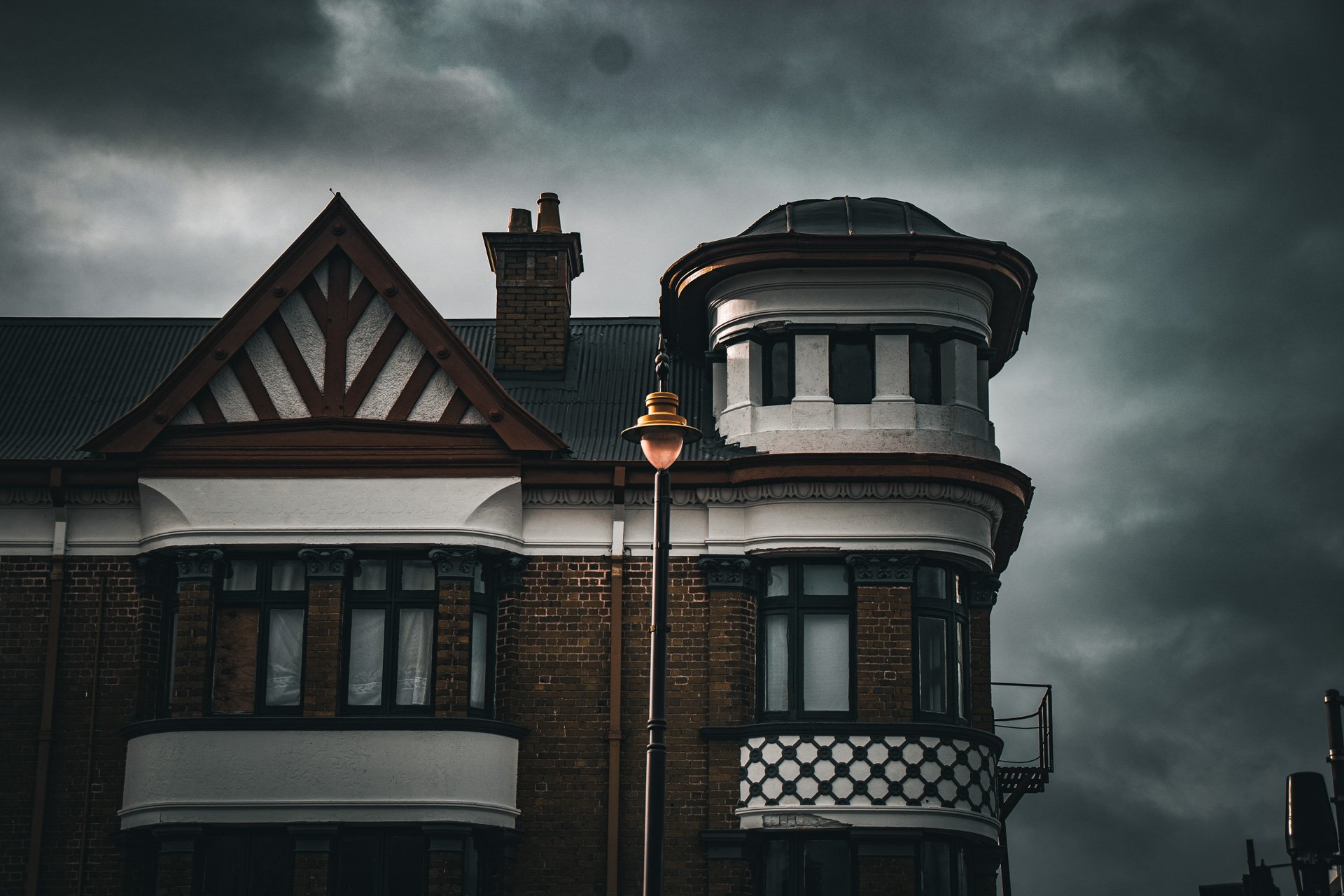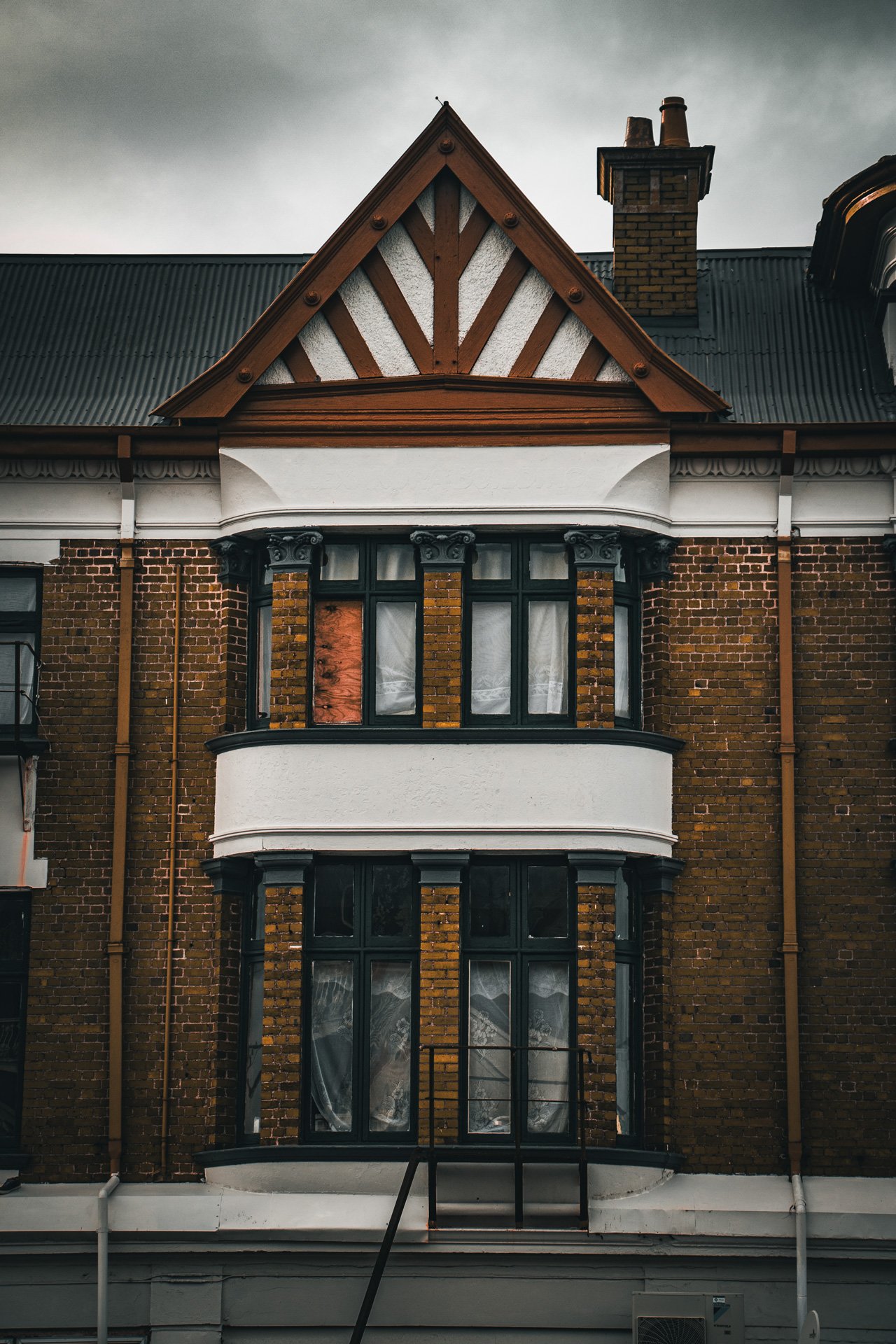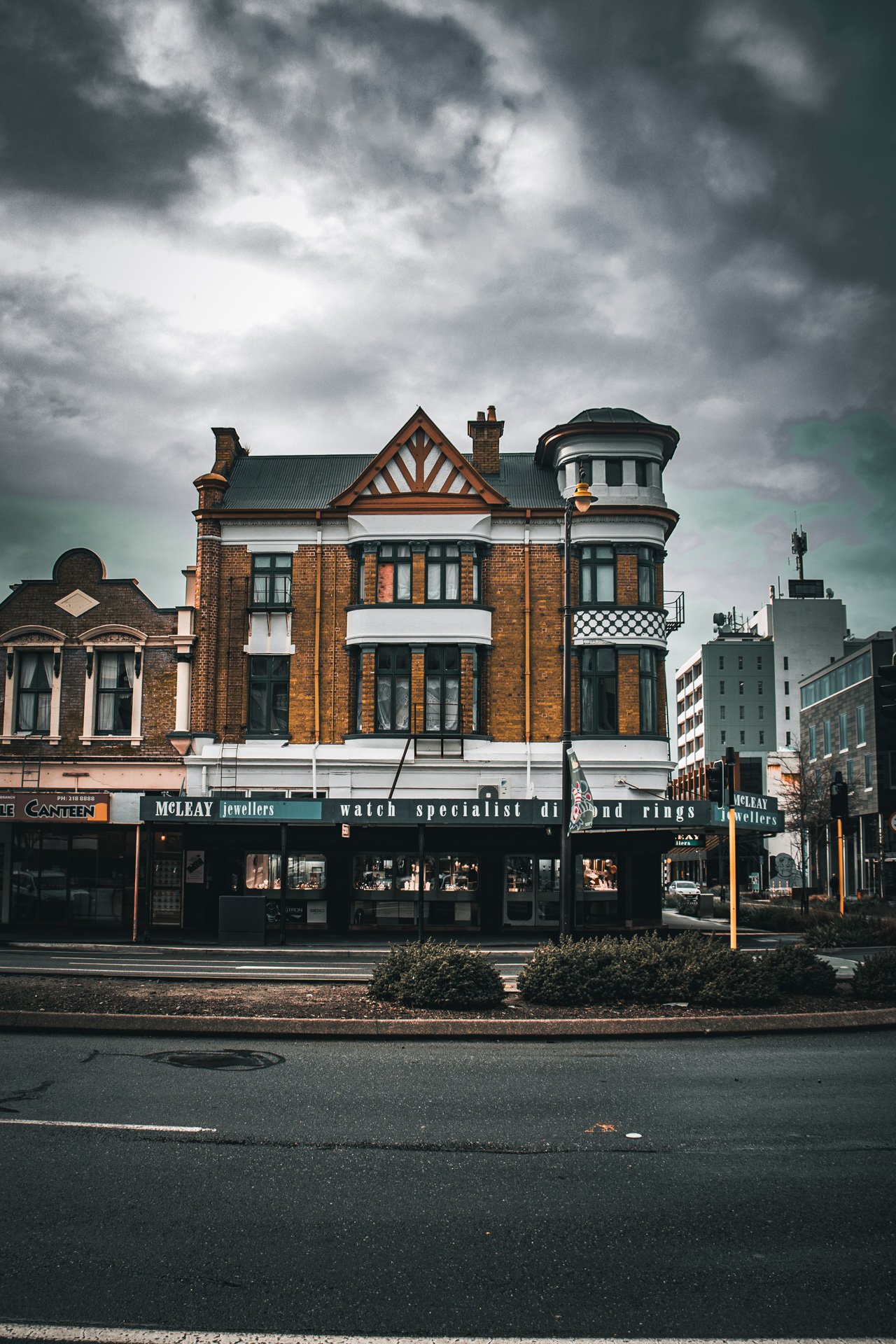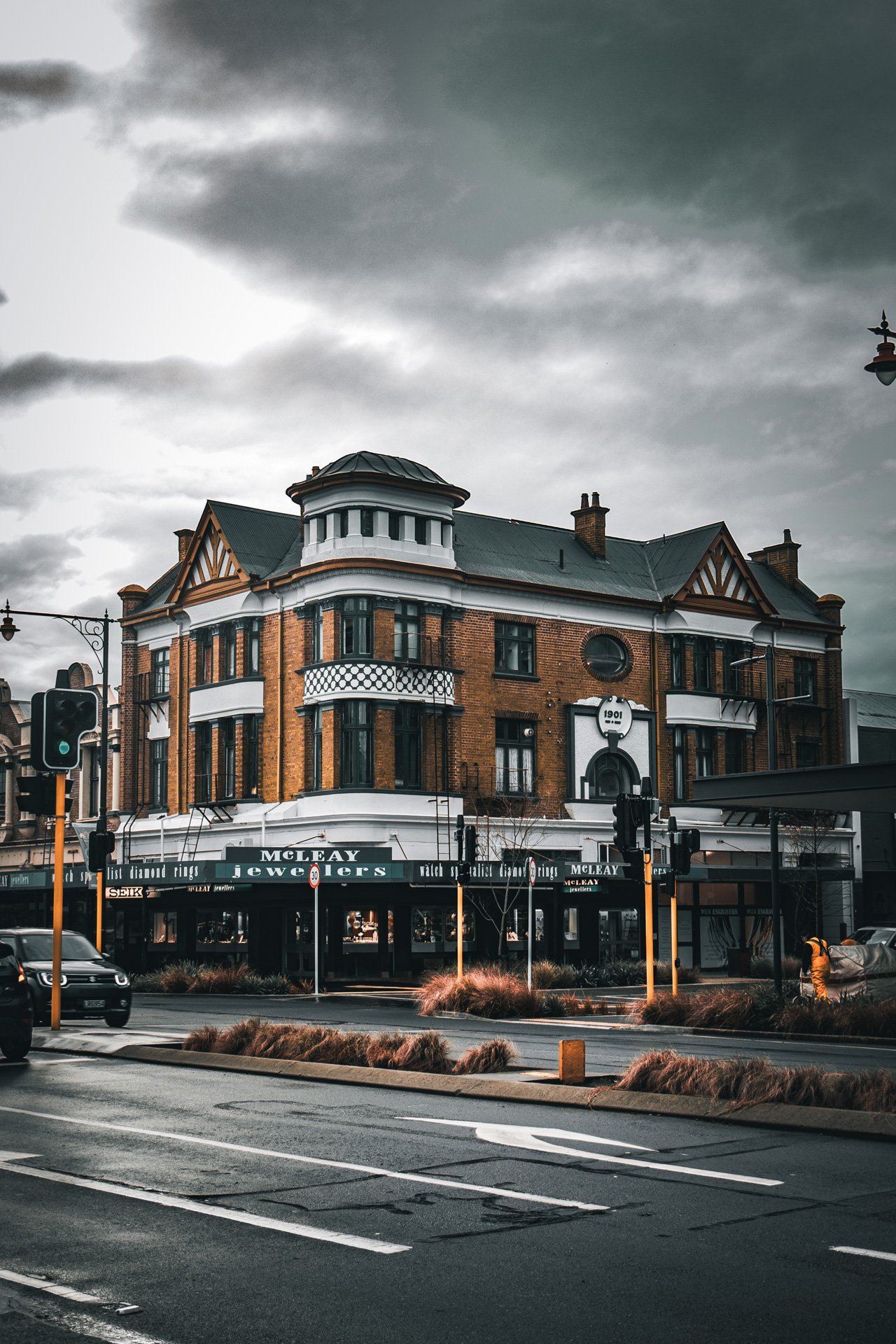
Invercargill City Council Archives, Ref: A0010 S00940014
Alexandra Buildings
Lots 11 and 12 DP 2107
This Queen Anne-style building was erected during the first year of the 20th century and is considered one of the city’s most handsome buildings. This three-storey brick building was commissioned by the trustees of the John Turnbull Thomson estate, and it was one of the first contracts for C.J Brodrick following the opening of his architectural practice in the National Bank Chambers, the Crescent in May 1900.
Construction of this as-yet-unnamed building began in October of that year, following the demolition of the wooden buildings previously on this site. It came to be known as the Alexandra Buildings following King Edward VII's ascension to the throne in January 1901, following the death of his mother Queen Victoria. His wife, Alexandra of Denmark, was a very popular consort with many public roads, streets and parks throughout the UK named in her honour. There was also a fountain, a palace and a bandstand named for her and in New Zealand, this newest building of the time in Invercargill and the township of Alexandra in Central Otago were added to the list.
-
83 Dee Street/2 Don Street
Dee Street Historical Area -
Architect: C.J. (Cuthbert John) Brodrick
Builder: Mair Brothers - building contract over £4,000
Completed: March 1901
With Invercargill’s population expanding, the Alexandra Buildings were built to provide shop and office space when building activity ramped up in the town. It was completed in March of 1901 and among the first tenants to take up residence were:
Mr E.S Perry - was a nurseryman who regularly advertised that he could supply “all your garden requisites.”
Mr J.D Mitchell - offered the dual professional services of both a certified optician and a surgeon dentist.
The Invercargill Cycling Club - leased the top-floor flat. They formed as a society in 1884 and officially became a club in 1893, holding regular runs, races and sports days. In 1903 they joined forces with the Physical Culture Club with the whole top floor providing social rooms for card games and reading, and a billiard room including ping pong tables. At this time, membership was around 200 and consisted mainly of younger men.
Misses Buchanan and Heywood - were dressmakers who could “fashion the latest styles in ladies' costumes” for the discerning women of the province at a time when ready-to-wear fashions were only just becoming available.
History.
Alexandra Buildings, and Don Street, Invercargill. Parker, I W (Mr), fl 1976 :Postcards of New Zealand scenes. Ref: PAColl-5908-004. Alexander Turnbull Library, Wellington, New Zealand. /records/22652758
Over the years, it has also been home to a range of organisations and private individuals, and some of the more interesting or unexpected tenants include:
The Edison Agency - intriguingly titled importers of the Edison phonographs and records, were advertising their wares in the Alexandra Buildings between April 1904 and November 1905. They briefly relocated two blocks south to the Lumsden Building, opposite the Post Office where the “1000 gold-moulded records just landed direct from the USA” could be viewed. They next appeared in the Southern Cross in 1906 at the Phonograph Supply Store in the Arcade, Esk Street and then two years later in Vickery’s Building, Tay Street, opposite T. Hides. The Edison Agency seems to have been taken on by William Christie in Main Street Gore, where he advertised in June 1929, his intention to give up the agency and clear all his remaining stocks.
During WWI, the local ambulance association offered First Aid training which proved so popular they required a larger classroom space. This was due to so many locals, particularly women, wanting to participate in their ambulance training sessions. The association secured their new premises in the Alexandra Buildings in 1916, above the drapery firm of Messrs Masters & Sons.
The Alexandra Buildings have had surprisingly few owners for a building more than 120 years old. John Turnbull Thomson’s Estate, which had it built, put it up for sale in December 1920. Terms were advertised as a 10% deposit with 5% in 3 months, a further 10% in two years and the balance in 5 years at 5.5 percent. It was bought by William A. Brown, whose family owned it through into the 21st century.
Stories.
Street scene in the city of Invercargill. Ref: 1/1-010968-G. Alexander Turnbull Library, Wellington, New Zealand. /records/22844838
Minna Kober, known professionally as Madame Heller, was a psychometrist, physiognomist and lecturer on spiritualism who toured New Zealand in the first half a dozen years of the 20th century with her son James Heller-Kober, a metaphysician and magnetic masseur. The family was from Dunedin, but following the death of her husband in November 1895, she and her son carved a new life for themselves on the road.
They visited Southland from January to March 1904, returning to Invercargill and taking up residence in the Alexandra Buildings for a short time in December. Spiritualists and psychics were obviously sought after in the early days of the new century as the Alexandra Buildings played host to not only the Heller-Kobers but also Australasian psychic orator and clairvoyant W. Norton Taylor P.C.T.M who held his clinics in rooms there next to the Alexandra Tea Rooms, which had opened earlier that year.
Clairvoyants, Illusionists and Psychometrists -
The Madame Heller story
Two Madame Hellers
It seems our Madame Heller was not the only Madame Heller active in the spirit entertainment field in New Zealand at that time. There was also a Madame Mandeena (the pale Mahatma) from Heller’s Mahatma Company, touted as a celebrated trance medium, Rosicrucian and entertainer. She, along with Professor G.W Heller, conjurer and illusionist, had also toured around New Zealand. Madame Heller’s ‘amazing talent’ was that she answered questions from the audience which had been written on slips of paper while Mr Heller wowed audiences by producing an umbrella full of paper flowers from a roll of cartridge paper and shillings from unlikely places such as men’s moustaches.
Minna Kober took steps to rectify this confusion by writing to the Pasquin, the author of the Otago Witness Theatrical & Musical Notes column twice - first in October 1899,
“Will you kindly draw attention to the fact that I am in no way connected to the Heller Mahatma Company but am a genuine psychometrist, whose gifts consist in highly-cultivated touch and naturally mental clairvoyance without trance, and must not be mistaken for the Madame Heller of that company. Your notices of that company have given rise to a great deal of confusion, to my loss.”
and then again in February of 1904 from Invercargill, in response to a letter from George Callendar, manager of Clement L. Wragge and promoter of Heller’s Mahatma Company, who had questioned Madame Heller-Kober advertising. This time she asserted her right to use Heller as it was her father’s name and that she had nothing to do with palmistry or stage performances.
She and her son James continued to tour the South Island and the lower North Island until April 1906, when she was hospitalised in Wellington, subsequently succumbing to pneumonia and heart failure in July at the age of 55. She is buried in the Northern Cemetery in Dunedin beside her husband and two sons.
Madame Heller (front left) punting on the River Avon, Christchurch near the Botanic Gardens Footbridge - January 1904
Christchurch City Libraries, CCL-Arch892-041-013
The Jewel on the Corner.
There has been a jewellery business in the prime corner location of the Alexandra Buildings for over 100 years. Keep your eyes peeled for this story - coming soon!
Follow the Heritage South website to find out when this story goes live.
Useful links
